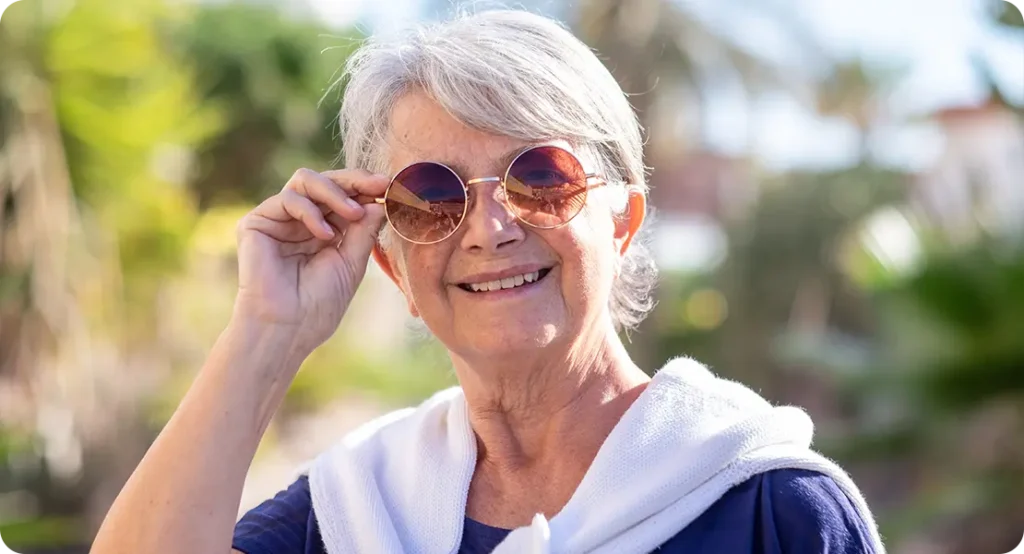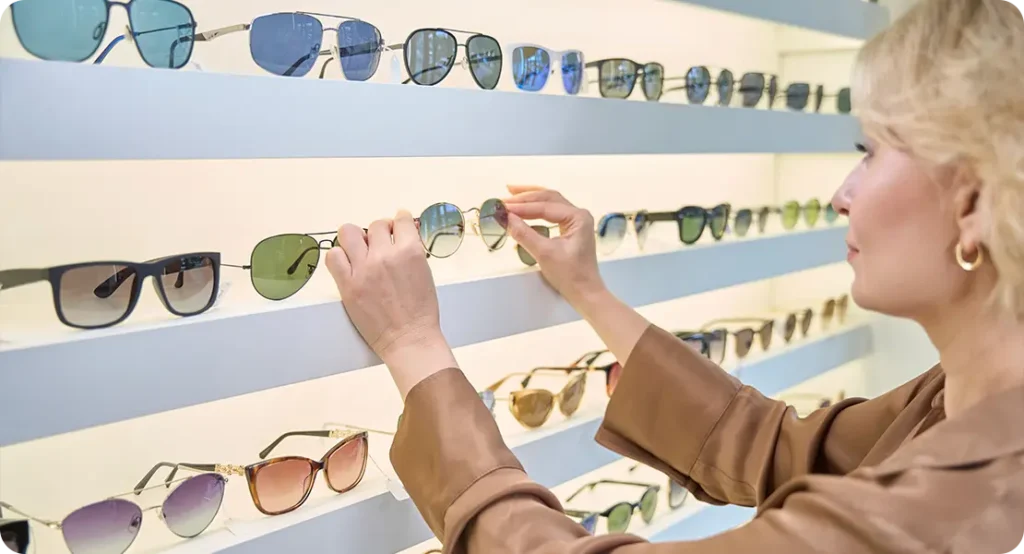Cataracts are among the most common causes of vision impairment across the globe, especially in older adults. Many people are aware that exposure to sunlight can damage the skin, but fewer realise the long-term impact it can have on the eyes. As sunglasses are often promoted as a protective measure, a natural question arises—can they really help prevent cataracts? And if so, what kind should we be wearing?
What Are Cataracts?
A cataract is the clouding of the eye’s natural lens, which lies just behind the iris. This clouding prevents light from passing clearly through the lens, leading to blurred or dimmed vision. Cataracts can develop in one or both eyes, though they don’t spread from one eye to the other.
The condition usually progresses slowly and is more common with age, though it can also result from trauma, certain medications, or medical conditions like diabetes. Early symptoms may include sensitivity to light, faded colours, difficulty seeing at night, or frequent changes in eyeglass prescriptions.
Surgery is the only definitive treatment for cataracts, which involves replacing the clouded lens with an artificial one. However, preventative measures—including protecting the eyes from UV radiation—can help delay or reduce the likelihood of cataract formation.
How UV Light Contributes to Cataract Formation
Ultraviolet (UV) radiation from the sun consists primarily of two types of rays that reach the earth’s surface—UV-A and UV-B. Although these rays are invisible to the naked eye, they carry enough energy to cause biological damage. While the skin is commonly recognised as being susceptible to UV harm, the eyes are equally vulnerable. The lens of the eye, in particular, is sensitive to prolonged exposure, which can gradually degrade its structural integrity.
One of the key ways UV light damages the eye is by altering the proteins within the lens. These proteins are responsible for maintaining the lens’s transparency and flexibility. Over time, exposure to UV radiation can cause the proteins to clump together or change form, resulting in cloudiness and reduced clarity. This process, often driven by oxidative stress, interferes with the transmission of light through the lens and is a recognised trigger for the development of cataracts.
Unlike a one-time injury, the impact of UV radiation on the lens is slow and cumulative. Each time the eye is exposed to sunlight without proper protection, small amounts of damage occur—often without any immediate symptoms. These micro-injuries accumulate over the years, eventually leading to noticeable vision changes. People who work or spend large amounts of time outdoors, such as gardeners, lifeguards, construction workers, or outdoor sports enthusiasts, are especially at risk.

The correlation between UV exposure and cataract formation is not merely theoretical. Numerous laboratory studies have demonstrated that UV light can accelerate lens opacity in animal models. Moreover, long-term population studies have shown higher cataract rates in individuals living in sunnier regions or in those with higher lifetime exposure to sunlight. These findings have helped solidify the scientific understanding that UV radiation is a significant environmental risk factor for cataracts.
As a result of these insights, leading eye health organisations and professional bodies now advise the use of protective eyewear as a preventive measure. Sunglasses with certified UV protection are widely endorsed as a practical and effective way to reduce cumulative UV damage. Alongside other strategies such as wearing hats and avoiding direct sunlight during peak hours, regular use of UV-blocking sunglasses has become a central recommendation for safeguarding long-term ocular health and delaying the onset of cataracts.
The Role of Sunglasses in Cataract Prevention
Sunglasses play a critical role in shielding the eyes from harmful ultraviolet radiation, acting as a barrier that limits the amount of UV light reaching the delicate internal structures of the eye. While they are often worn for comfort or fashion, their true value lies in their ability to filter out UV rays and reduce overall light exposure. This dual function not only enhances visual clarity in bright settings but also serves a more long-term protective purpose by helping to prevent the slow degradation of the lens that can lead to cataracts.
However, not every pair of sunglasses offers this level of protection. Some may simply darken the visual field without blocking UV rays, giving a false sense of safety. For sunglasses to be effective in preventing cataracts, they must provide complete protection against both UV-A and UV-B radiation. These two types of rays penetrate the atmosphere and can cause significant cellular changes in the eye over time. A reliable indicator of proper protection is a label stating “100% UV protection” or “UV400”, which confirms that the lenses block radiation up to 400 nanometres in wavelength—the full range of harmful UV rays.
The mechanism behind their protective effect is relatively simple: by reducing the volume of UV radiation that enters the eye, sunglasses limit the cumulative damage that would otherwise affect the lens. Since cataracts develop slowly due to long-term exposure to environmental stressors, any reduction in this exposure can make a meaningful difference. Just as sunscreen defends the skin from photoageing and disease, UV-filtering lenses can help safeguard the lens of the eye from the kind of protein changes that lead to cloudiness and vision loss.
Crucially, the benefits of sunglasses are not automatic—they depend on how consistently and correctly they are used. Occasional use, or wearing sunglasses only during particularly sunny days, may offer some benefit but will not fully counter the chronic effects of UV exposure. Maximum protection comes from making sunglasses a daily habit, especially during outdoor activities or when sunlight is reflected off surfaces like water, sand, snow, or concrete. Wearing them even during overcast days can be wise, as UV rays can penetrate cloud cover.

Ultimately, high-quality sunglasses are a simple, accessible, and non-invasive strategy for protecting the eyes over a lifetime. While they cannot prevent all causes of cataracts—since factors like age, genetics, and health conditions also contribute—they do offer a meaningful defence against one of the few modifiable risk factors. When combined with other healthy habits, such as avoiding smoking and maintaining good nutrition, wearing proper sunglasses becomes a powerful tool in preserving clear vision for as long as possible.
What to Look for in Sunglasses for Cataract Prevention
If you’re thinking about getting sunglasses to protect your eyes, it’s important to choose the right pair. Not all sunglasses offer the same level of protection, and some might even do more harm than good. To reduce your risk of cataracts, you need to look for specific features that genuinely protect your eyes from UV damage.
Many cheap sunglasses only darken your vision without blocking UV rays, which can trick your eyes into letting in more harmful light. This is why it’s crucial to focus on quality, not just appearance. Choosing sunglasses with proper protection gives your eyes a real defence against long-term damage, especially if you wear them regularly.
Think about when and where you’ll use them. If you’re outdoors a lot—whether driving, walking, or working—you’ll want sunglasses that are not only protective but also comfortable and durable. It’s worth investing a little more in a pair that ticks all the right boxes.
1. UV Protection
This is the most important thing to look for. Your sunglasses should block 100% of UV-A and UV-B rays. Look for a label that says “UV400” or “100% UV protection”. Without this, you could be wearing dark lenses that actually increase your risk by allowing more UV rays into your eyes.
When your pupils dilate behind dark lenses, they let in more light—and if that lens isn’t properly treated, you’re letting in more UV too. So never assume darker lenses mean better protection. Always check the label or ask your optician if you’re unsure.
Remember, UV protection isn’t something you can see. It’s not about how dark the lenses are—it’s about what they block. Even light-tinted lenses can offer full UV protection if they’re made properly.
2. Lens Quality
Good-quality lenses help your eyes relax. They don’t distort your vision, and they reduce strain when you’re out in bright light. Poor lenses can make your eyes work harder than they need to, causing fatigue or even headaches.
High-quality lenses also tend to come with coatings that make them scratch-resistant or reduce glare. This can be a big plus if you wear sunglasses often or lead an active lifestyle. It’s also something you’ll notice in terms of comfort.
You should also consider the lens material. Polycarbonate lenses, for example, are lightweight, impact-resistant, and naturally block UV rays. They’re a great option if you want something safe and comfortable, especially for active use.
3. Wraparound or Oversized Frames
Frame design makes a real difference. Wraparound sunglasses or oversized frames offer more protection by covering the sides of your eyes, not just the front. UV rays can bounce off surfaces and reach your eyes from different angles, so full coverage matters.
If you’re around water, snow, or even pavement, those reflections can be intense. Wraparound frames stop light sneaking in from the sides, which is especially useful in bright or high-glare environments.
Even in everyday settings, these designs reduce the need to squint or constantly adjust your glasses. They keep you more comfortable and better protected, which is the whole point.
4. Polarisation (Optional but Helpful)
Polarised lenses cut down glare from reflective surfaces like water or roads. They make everything look clearer and more comfortable, especially on sunny days. But keep in mind—polarisation doesn’t block UV rays on its own.
To get the full benefit, polarised lenses must also include UV protection. When combined, you get both safety and comfort. This is especially helpful if you drive a lot, spend time outdoors, or are sensitive to bright light.
If you don’t often deal with glare, you might not need polarisation. But if you do, it’s a great addition—just make sure the lenses are still labelled as offering full UV protection.
5. Lens Colour and Tint
Lens tint affects how your eyes feel in different lighting but doesn’t impact UV protection. You could have very dark lenses that don’t block UV at all—or light ones that block everything harmful. It’s the coating that counts, not the colour.
Grey and brown tints are good all-rounders. Grey keeps colours looking true and reduces brightness, while brown adds contrast and works well in hazy or variable conditions. Both are easy on the eyes and great for daily wear.
Unless you have a specific need, like yellow tints for low light or green for extra contrast, you’ll be fine with grey or brown—just make sure they have proper UV certification.

Do Children Need Sunglasses Too?
Yes—children definitely need sunglasses. Their eyes are still developing, and their lenses are clearer than yours, which means more UV gets through to the back of the eye. That makes early protection really important.
Kids often spend a lot of time outside, especially in summer. Making sunglasses part of their daily routine is one of the best things you can do for their long-term eye health. It’s like sunscreen for their eyes—easy, cheap, and effective.
Look for sunglasses that block 100% of UV, fit well, and are made from tough, impact-resistant materials. Polycarbonate lenses are a great choice. And if they’re fun to wear, kids are more likely to keep them on.
Can Sunglasses Alone Prevent Cataracts?
Sunglasses are a big help, but they’re not a complete solution. Cataracts can also come from age, genetics, health conditions, or even medication. Still, sunglasses cut out one of the few risks you can actually control—UV exposure.
Wearing proper sunglasses, especially when the sun is strongest, reduces long-term damage to the lens of your eye. If you make it a habit, you’ll be protecting your vision every single day without much effort.
For even better results, combine sunglasses with other healthy habits—wear a hat in the sun, eat antioxidant-rich foods, manage conditions like diabetes, and avoid smoking. It’s all part of keeping your eyes clear and healthy for as long as possible.
Final Thoughts
So, do sunglasses really help prevent cataracts? The evidence strongly suggests they do—provided they’re high-quality, offer full UV protection, and are worn regularly in sunny environments. Choosing the right pair doesn’t need to be expensive or complicated, but it does require a bit of attention to detail.
In the same way we wear sunscreen to protect our skin, wearing sunglasses should become second nature for protecting our eyes. It’s a small step with potentially significant benefits for maintaining clearer vision well into later life.
If you’re concerned about cataracts or would like personalised advice, you’re welcome to contact us at the London Cataract Centre to book a private consultation with one of our cataract specialists. We’re here to help you protect and preserve your vision with expert care.

